These are just fun. Giraffe feeding time at Santa Barbara Zoo.
Photos copyright Tim Jones.
As I haven’t posted anything for a while, this is just to say I’m still here (yes, sorry), and normal service – whatever that is – will be resumed as soon as possible. Anyhow, photos are easy ! So here are three I took at Santa Barbara Zoo last summer, including the inspiration for Mac’s latest operating system.
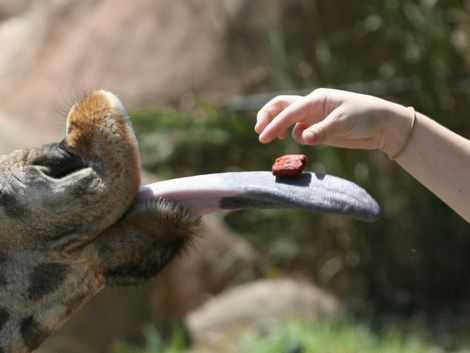
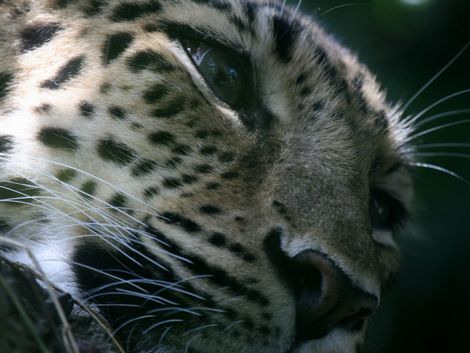
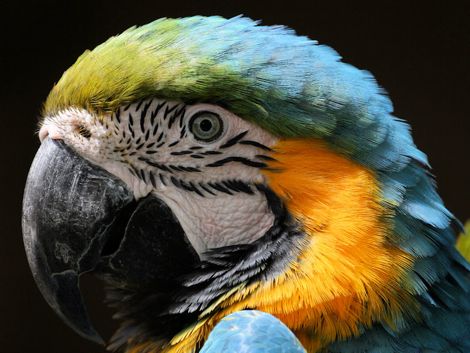
The Zoo is brilliant by the way. I saw no distressed animals (they’re living in SB for crisakes!) – and I recommend it. $5 to feed the giraffe.

(Update 4th November 2011. We were very sorry to hear of Alan’s death earlier today. A fantastic guy and unmatched friend of gibbons. Rest in peace Alan.)
What better way to spend Christmas than in the company of your favourite gibbons? That’s exactly what my wife Erin and I did on the 26th December 2008, on our second visit to the Gibbon Conservation Center at Santa Clarita, California – home to some of the world’s rarest gibbons.
As well as catching up with gibbon families first met in September and described in this earlier post, I recorded the gibbons singing, and an extended interview with the Founder and Director of the Center, Alan Mootnick.
Much of what Alan has to say about working in gibbon conservation with various institutes, authorities, and peoples around the world, and particularly in Asia, is also relevant to other species.
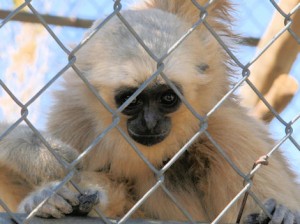
Each recording lasts between 3 and 10 minutes, with the entire interview as one edit included at the end.
An early morning tour ends in a noisy chorus.
Alan introduces the aims of the Center, the various gibbon genera and species, and gives a disturbing account of the threats facing wild gibbons.
Alan describes the breeding program for the Javan gibbon – of which only 4000 remain in the wild, the Center’s collaboration with zoos – including in the UK, and the challenges of finding gibbons for study in the wild.
Gibbon genomics, taxonomy, and a showcase of mistaken identity. The challenges of moving gibbons and their DNA around the world, and the role of faeces in working out bloodlines.
Including apparent similarities with man, and discussion around gibbon song and brachiation (swinging arm to arm). The highlight is Alan’s empirically supported theory of hostile genital or anal presenting – ‘gibbon mooning’ in other words.
Including the possibility of joining the Center from the UK.
Discusses issues around land management and deforestation in Indonesia, the illegal trade in gibbons, and the impact that’s having on the gibbon population. Also some tips on how to work to best effect when dealing with zoos in Asia.
And this is the entire interview as a single edit:
*********
60Mb. Approx. 1 hour. Copyright, all rights reserved, 2009, Tim Jones communicatescience.com
*********
If you enjoyed hearing about – and hearing ! – the gibbons of Santa Clarita, and would like to make a donation, you can do so here.
(Update 4th November 2011. We were very sorry to hear of Alan’s death earlier today. A fantastic guy and unmatched friend of gibbons. Rest in peace Alan.)
What better way to spend Christmas than in the company of your favourite gibbons? That’s exactly what my wife Erin and I did on the 26th December 2008, when we made our second visit to the Gibbon Conservation Center at Santa Clarita, California – home to some of the world’s rarest gibbons.
As well as catching up with gibbon families we first encountered in September, and described in this earlier post, I made some sound recordings during this visit, including an extended interview with the Founder and Director of the Center, Alan Mootnick.
I hope you’ll find the resulting podcast, which you can stream or download below, gives an in-depth, candid, yet often humorous insight into the mission of the Gibbon Center, the plight of the gibbon, and the work of a dedicated scientist and hands-on conservationist.
(Please note, a later edit with the interview split down into six shorter sections can be found here)
*********
60Mb. Approx. 1 hour. Copyright, all rights reserved, 2009, Tim Jones communicatescience.com
*********
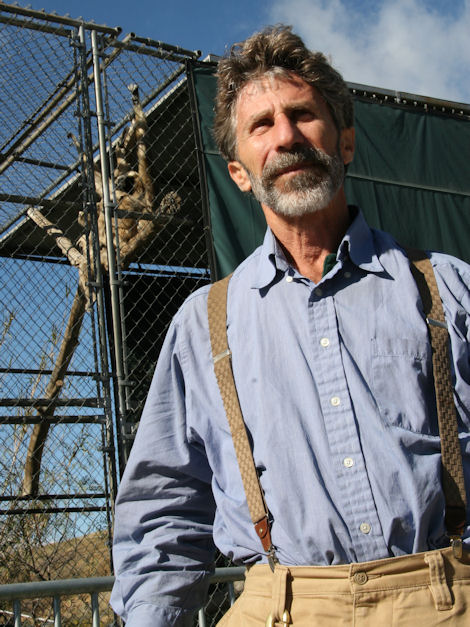
If you enjoyed hearing about – and hearing ! – the gibbons of Santa Clarita, and would like to make a donation, you can do so here.
Last month, the International Primatological Society reported that nearly 50% of the world’s 634 primate species and subspecies are in danger of going extinct, with more than 70% of species in Asia coming under near term threat. Reading this on the way out to the USA earlier this month set a grim backdrop to an encounter I had very much been looking forward to.
Gibbons are found in three places: the jungles of Asia, the zoo, and, the subject of this post – a gibbon conservation center.
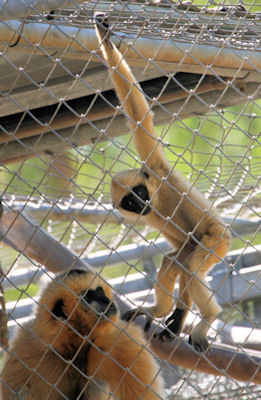
It was with bleary eyes that Erin and I arrived at the Gibbon Conservation Center in Santa Clarita, California, at the virtuous hour of 7.15 a.m. Erin had arranged the visit with Director and founder Alan Mootnick, as an anniversary present (I am a lifelong fan of these hairy cousins). Not an all-comers zoo, the Gibbon Center welcomes groups and serious researchers by appointment, so the personal tour was a bonus; a little politeness and a sensible donation helps.
The declared mission of the Center, established in 1977, is to help ensure the survival, preservation, and propagation of all gibbon species in the wild and captivity, to provide a captive haven for gibbons as a complement to protecting them in the wild, to educate the public and to further our knowledge of gibbon care, and to support ongoing field projects.
Alan warmly welcomed us at the gate and introduced our feet to a tray of disinfectant. Gibbons are highly susceptible to human disease and, with forty in residence, precautions are essential. It is unsettling to learn that more than 75% of Americans have oral herpes but downright scary that the gibbons who contract it will be dead within four days. Volunteers are the lifeblood of this Center, but medical tests are a pre-qualification.
The wire fenced compound houses several individual cages of gibbon family units – typically a male, a female, and one or two offspring. The family theme is very strong and not artificial – this is how gibbons live. One group we became absorbed with comprised a darker haired, white-bewhiskered male, a golden female partner nursing a gangly infant of 1yr, a hyperactive younger son, and an older sister – visible to, but separated from, the group; the consequence of uncontrollable spats at meal times. Anthropomorphising animal behaviour may not be in vogue or politically correct with some, but after three hours close to these families the parallels in behaviour to our own are obvious – whether we like it or not.
A successful breeding programme is essential to meet the Center’s conservation goals, and there was evidence aplenty of this during our visit. Between the five families on which we focused, we saw three recent offspring (including the acrobatic ‘Canter’ in the photo above) and two evident pregnancies. Such prolific reproduction is one indicator that the animals are relatively happy in their captivity. Also, while the chainlink fencing looks intimidating to us, its regular geometry and strength makes it popular with the gibbons, who strangely have spurned more sophisticated apparatus provided for their brachiating delight (that is their characteristic swinging from arm to arm). We certainly saw no evidence of the repetitive and obsessive rocking behaviours characteristic of bored, disturbed or mistreated animals. With no less than nine separate feedings a day, there is little chance of gibbon ennuie setting in within this community.
While Mootnick clearly cares deeply about his charges, he is not overly sanctimonious in pursuing his task. He delights in the gibbon’s hesitant yet rapid two legged walk, likening it to a man walking on hot coals. Indeed, the gibbons’ entertainment value may be their salvation; during the tour a call came in from a major TV company keen to film at the Center, and its not the first time, as this sequence for the L.A. Times and this half-hour interview with Alan Mootnick shows.
Inevitably, the conservation business has its own politics. The main players are zoos providing a more corporate approach; then the ‘activists’ – who seem driven mostly by the principle of keeping gibbons in their countries of origin; then groups like Alan’s (his model is not unique) – which, while a team effort, is also personally inspired with a flexibility that I sensed is not always endearing to more regimented interests. But from the recent visits and best practice exchanges that Alan described – not to mention gibbon exchanges – the Center is an important part of an informal network that essentially pulls together. 2% of donations to the Center go to support projects devoted to conservation of wild gibbons.
Despite the Center’s success, encroaching humanity from an enlarging Santa Clarita is threatening the gibbons and driving the current imperative and funding appeal to relocate and expand operations. Details are on the Centre’s website.
I will be following the fortunes of these California residents with interest, and plan to call in at the Center again over the new year. In the meantime, I would encourage anyone to learn more about the plight of primates, and especially gibbons, and consider supporting the Gibbon Center if you are able.
Other Links
BBC online article by Russell Mittermeier of the International Union for Conservation of Nature